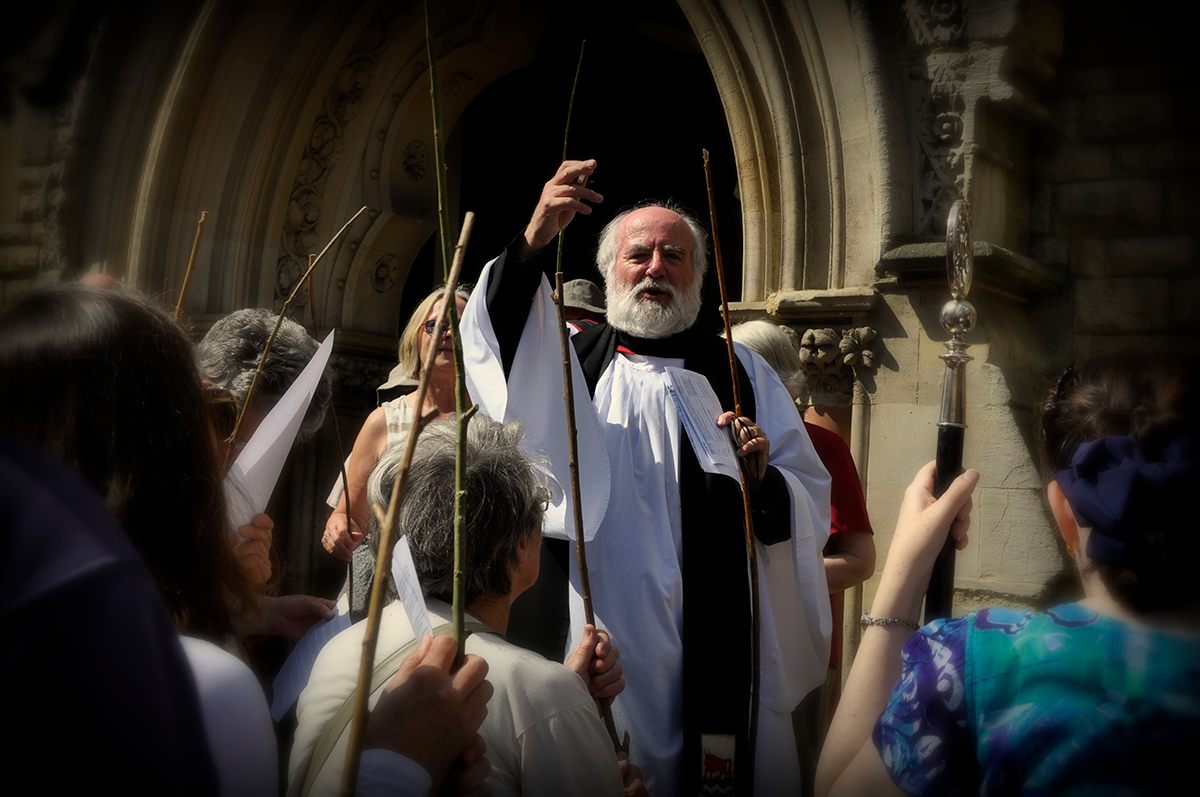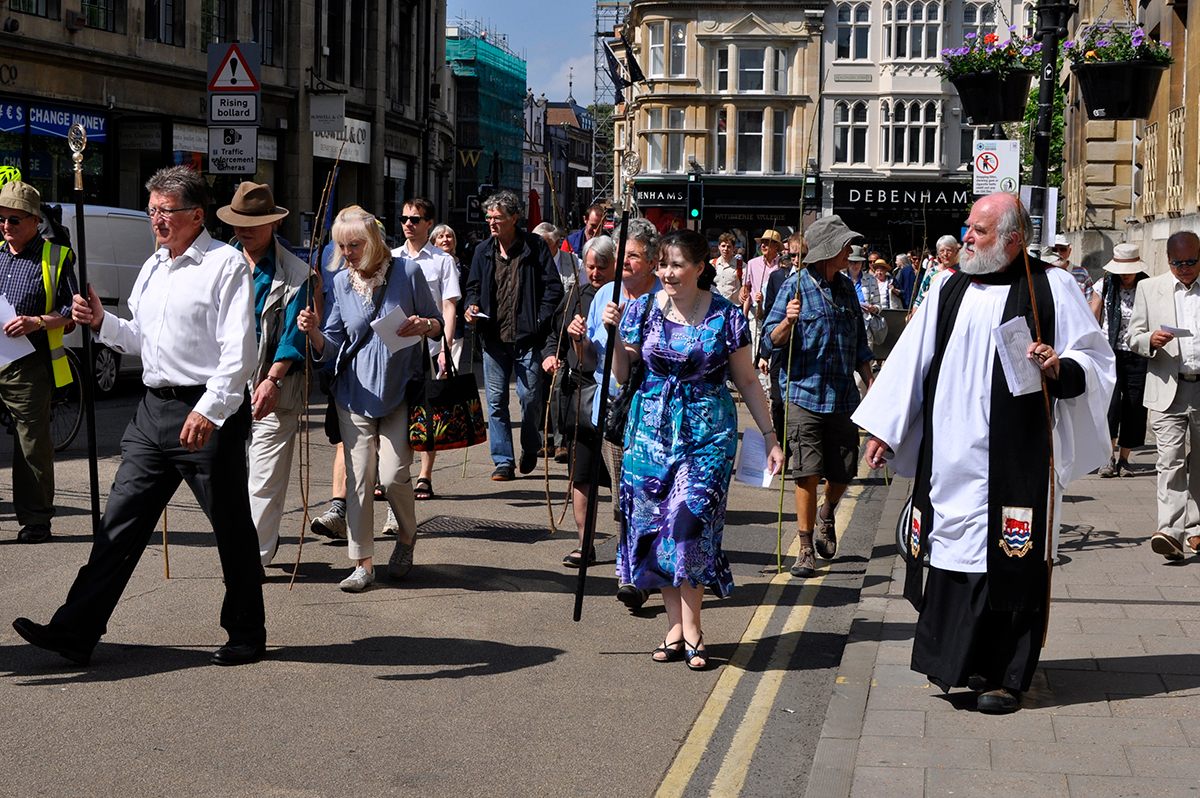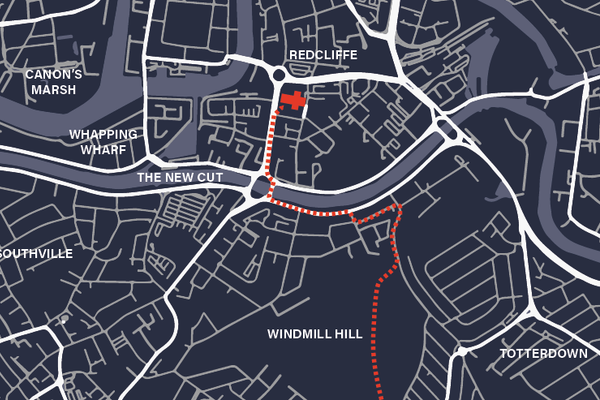The Delightful English Tradition of Beating Parish Boundaries With Sticks
Or, why you may have seen 40 branch-wielding people in Oxford shouting “Mark, mark!”

At the back of the women’s shoe section of the Marks and Spencer department store in Oxford, England, behind a rack of summer sandals, next to the elevator, you’ll find an odd thing. It’s out of place, doesn’t belong among this season’s pumps and slingbacks. Shoppers pass by oblivious, not noticing there’s a relic of ancient Oxford right under their noses.
The mysterious object is a carved stone, protected by a glass panel set into the wall. It reads; St Peter le Baily, St Martin, All Saints and St Aldate.
The stone used to stand in an alleyway that was later engulfed by the store. It marked the boundary between three ancient church parishes, its original position shown by a metal plaque in the floor nearby.
On Ascension Day*, a priest with a white beard, robes flowing behind him, strides past a display of sunglasses followed by 40 people all carrying long willow wands, taller than themselves. Store staff stand aside, shoppers pause to stare. The group gathers around the metal plaque. The priest kneels and writes on it with chalk, steps back and the crowd shout “Mark! Mark! Mark!”, beating the plaque with their willow wands.
“We’ve got to pick up the pace!” shouts the priest, dashing out of the doors and crossing the street into a shopping mall, followed closely by his motley congregation.
This is one of the last remaining observances in the U.K. of “beating the bounds,” a tradition with a 600-year history. A procession of church dignitaries and parishioners mark the borders of their parish by walking them and hitting marker stones with willow wands.

Today it’s the congregation of St Michael at the Northgate, the city church of Oxford, beating its bounds. St Michael’s is the oldest building in the city. Its boxy tower, now lost in a jumble of modern store frontages, once looked down on the muddy street grid of the Anglo-Saxon town, nearly a thousand years ago. Its parish lies roughly over the area enclosed by the medieval city wall.
“It was important to know which parish you were in,” says Reverend Bob Wilkes, vicar of St Michael’s. “The parish was the unit of local taxation, and rates could vary. If you were in a parish with a good rate you didn’t want that lot next door sneaking over and trying to get in on your plot. There was a defensive element; this is our boundary, you stay out!”
Beating the bounds was a kind of medieval data backup, a way to pass the knowledge of the parish boundary to the next generation.
The story goes that the clergy used to beat the choirboys with the wands at each stop, to impress upon them where their parish boundary was. That, unsurprisingly, is an element that’s been phased out. Today the beaters are mostly middle-aged parishioners, tourists and students.

Next stop is a boundary stone set on a wall above some garbage dumpsters in an alleyway behind a Japanese restaurant. The congregation crowds in, reaching high to beat the marker.
“We go through here,” shouts Reverend Wilkes, pointing at a grimy door in the wall. “It’s a restaurant kitchen. Don’t all come in at once.” The procession files through the kitchen, pausing to beat the stone in its back wall then out past the smiling chefs and confused diners.
So why, in an age of satellite mapping, when parishes are pretty much obsolete as a marker for anything much, is the route still walked?
“Oxford is a place where tradition is kept,” says Reverend Wilkes with a shrug.
But there’s something more. The beaters are clearly enjoying this strange peregrination behind the facades of the city, ploughing over flowerbeds, crossing quads, blocking roads, jostling through the goods entrance of the town hall while tourists gape and take photographs.
There’s something alluring about following a path that sticks a finger up at modern planning, ignoring social and commercial boundaries.
The oldest marker stone is in the back wall of the staff bike lock-up of the clothing store Zara. When the procession reaches it, a store manager is waiting to unlock it.

When he came to the church Reverend Wilkes inherited a map of the boundary stones and a spreadsheet of contact numbers for the people with keys to doors behind which hidden markers lurk.
“One year a young woman had just taken over as manager when I called,” says Reverend Wilkes. “She said her regional manager had told her there was something in the bike store. She wanted to know if it was spooky.”
The procession halts in the middle of Broad Street, one of Oxford’s main thoroughfares. Bikes swerve around them and trucks slow to a crawl. At their feet a patch of old cobbles has been left uncovered by generations of asphalt-laying road-crews. The cobbles are set in a cross as the marker here.
In a built environment that is increasingly off-bounds, owned, restricted, charged for, and in a technological age that increasingly divorces us from the physical, this is a kind of alternative cartography. It’s a mapping with the feet that charts the city of the past and pays little attention to the modern landscape of retail and business; a neural pathway in a community’s memory.

“Pilgrimage is a very ancient Christian tradition, and this is a brief pilgrimage,” says Reverend Wilkes. “When we mark our parish we mark that bit of Earth’s territory that is ours. In the Anglican tradition a congregation is given a part of the earth to pray and think about. Ours happens to be a chunk of the city center of Oxford.”
The beaters follow a different path than the workers on their way to offices, the morning shoppers, the students strolling to tutorials. They are pacing out a shape that becomes more difficult to trace each year. Today one marker is inaccessible behind a parked truck. Another has been permanently obliterated by an O’Neill’s Irish themed pub.
Reverend Wilkes pauses by a barred gate. “This is locked. It shouldn’t be.” The beaters stop, wands bristling. “The marker is through there,” he says, pointing. As if on cue, the gate silently swings open on hidden bearings, and the procession surges on.
*Correction: This piece has been updated to reflect the fact that the date of Ascension Day each year varies.






















Follow us on Twitter to get the latest on the world's hidden wonders.
Like us on Facebook to get the latest on the world's hidden wonders.
Follow us on Twitter Like us on Facebook